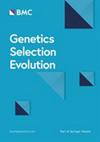赤足赛跑的能力是标准品种和冷血蹄马的遗传特征
IF 3.1
1区 农林科学
Q1 AGRICULTURE, DAIRY & ANIMAL SCIENCE
引用次数: 0
摘要
在马的运动中,鞋子是用来保护蹄子免受磨损的。在瑞典的小跑比赛中,脱鞋赤脚比赛很受欢迎,因为这样可以缩短比赛时间。良好的蹄质量对于高性能的马来说是必不可少的,但并不是所有的小跑马都有能够忍受光脚比赛的蹄。赤脚比赛的能力是一种复杂的特征,已知会受到环境因素的影响,但这种特征的遗传基础尚未得到研究。本研究的目的是估计三种新性状的遗传参数和估计育种值之间的相关性:两种性状与赤足赛跑的比例和“赤足状态”有关,这是一种反映在比赛中不穿鞋的可能性的二元性状,在瑞典标准种马驹(SB)和瑞典-挪威冷血马驹(CB)中。对于描述赤足人种比例的两个性状,采用单性状混合线性动物模型估计方差分量,最大方差为24,958 SB,最大方差为4050 CB。遗传率估计在0.17到0.28之间。对于赤脚状态,一个重复测量的二元特征,包括来自25,973个SB的875,056个观测值和来自3384个CB的93,376个观测值。利用单性状混合动物阈值模型估计赤足状态的遗传率分别为0.07和0.08。赤足状态的估计育种值与描述赤足种所占比例的各性状之间的Pearson相关系数分别为:SB为0.63和0.64,CB为0.82和0.76。所分析的反映赤足赛跑能力的性状是可遗传的,赤足赛跑比例的性状对两个品种的遗传率估计都高于赤足赛跑状态。这三个性状对种马的估计育种值呈中至强相关。所有性状的种马育种值估计值的平均准确度均为中高。为了培养赤脚比赛的能力,有必要进一步研究赤脚比赛能力与表现特征的遗传相关性以及赤脚比赛对职业生涯长度的影响。本文章由计算机程序翻译,如有差异,请以英文原文为准。
The ability to race barefoot is a heritable trait in Standardbred and Coldblooded trotters
In equine sports, shoes are used to protect the hooves from wear and tear. In Swedish trotting races, pulling off the shoes to race barefoot is popular because it improves racing time. Good hoof quality is essential for high-performance horses, but not all trotting horses have hooves that tolerate barefoot racing. The ability to race barefoot is a complex trait that is known to be influenced by environmental factors, but the genetic basis of this trait has not been studied. The aim of this study was to estimate genetic parameters and correlations between estimated breeding values for three novel traits: two related to the proportion of barefoot races and “barefoot status”, a binary trait that reflects the probability of racing unshod in a race, in Swedish Standardbred trotters (SB) and Swedish-Norwegian Coldblooded trotters (CB). For the two traits describing the proportion of barefoot races, single-trait mixed linear animal models were used to estimate variance components for up to 24,958 SB and up to 4050 CB. Estimates of heritability ranged from 0.17 to 0.28. For barefoot status, a binary trait with repeated measurements, 875,056 observations from 25,973 SB, and 93,376 observations from 3384 CB were included. Using a single-trait mixed animal threshold model estimates of heritability for barefoot status were 0.07 and 0.08. The Pearson correlation coefficient between the estimated breeding values for barefoot status and each of the traits describing the proportion of barefoot races for breeding stallions was 0.63 and 0.64 for SB and 0.82 and 0.76 for CB. The traits analyzed reflecting the ability to race barefoot are heritable, with the traits for the proportion of barefoot races showing higher heritability estimates for both breeds than barefoot status. Estimated breeding values for breeding stallions were moderately to strongly correlated for the three traits. The average accuracy of estimated breeding values for breeding stallions was moderate to high for all traits. To breed for the ability to race barefoot, further studies on the genetic correlation of the ability to race barefoot with performance traits and the impact of racing barefoot on career length, are necessary.
求助全文
通过发布文献求助,成功后即可免费获取论文全文。
去求助
来源期刊

Genetics Selection Evolution
生物-奶制品与动物科学
CiteScore
6.50
自引率
9.80%
发文量
74
审稿时长
1 months
期刊介绍:
Genetics Selection Evolution invites basic, applied and methodological content that will aid the current understanding and the utilization of genetic variability in domestic animal species. Although the focus is on domestic animal species, research on other species is invited if it contributes to the understanding of the use of genetic variability in domestic animals. Genetics Selection Evolution publishes results from all levels of study, from the gene to the quantitative trait, from the individual to the population, the breed or the species. Contributions concerning both the biological approach, from molecular genetics to quantitative genetics, as well as the mathematical approach, from population genetics to statistics, are welcome. Specific areas of interest include but are not limited to: gene and QTL identification, mapping and characterization, analysis of new phenotypes, high-throughput SNP data analysis, functional genomics, cytogenetics, genetic diversity of populations and breeds, genetic evaluation, applied and experimental selection, genomic selection, selection efficiency, and statistical methodology for the genetic analysis of phenotypes with quantitative and mixed inheritance.
 求助内容:
求助内容: 应助结果提醒方式:
应助结果提醒方式:


